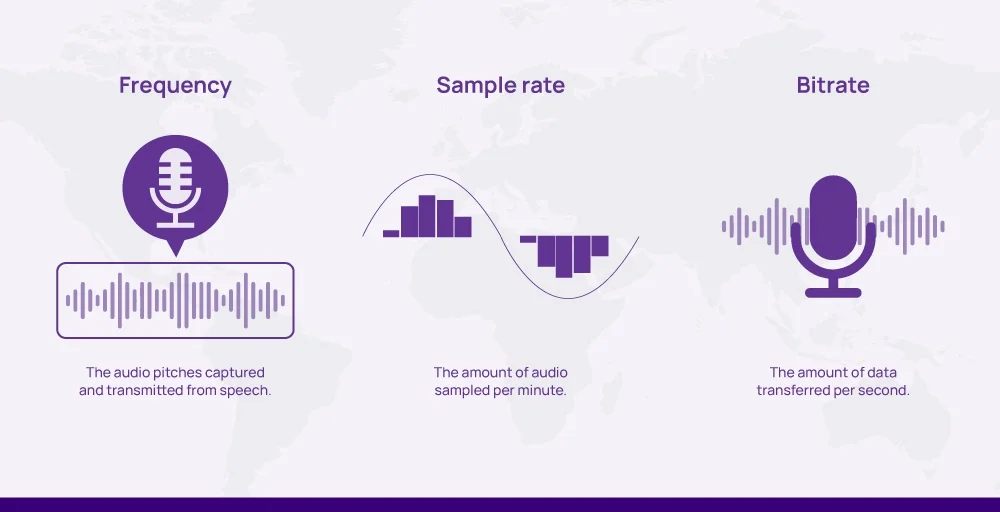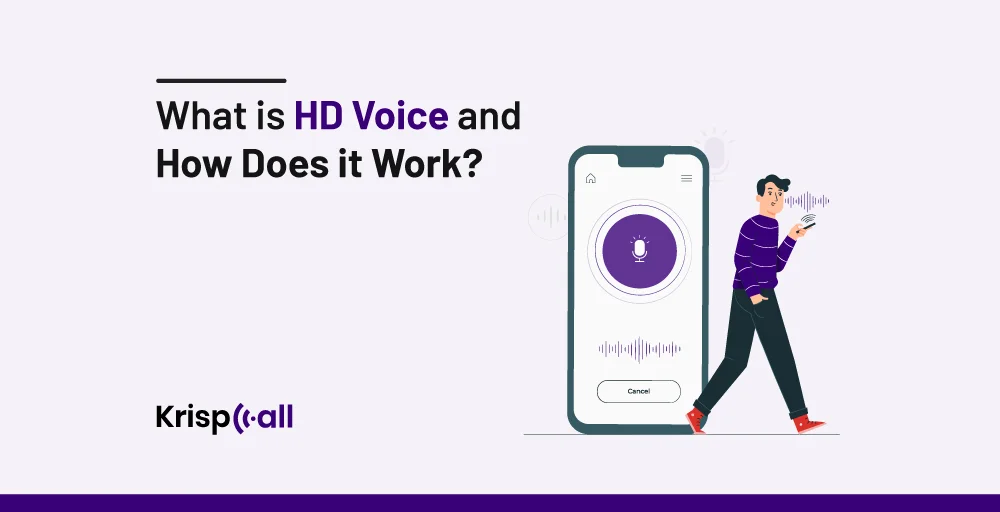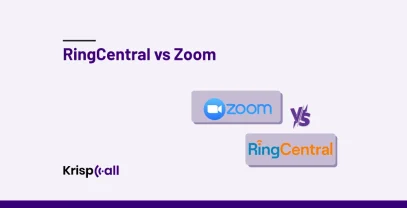Have you ever wondered why some calls sound clearer and more natural than others? This is simply the work of HD Voice. HD Voice is one of the most popular tools that make your phone calls sound better than ever! It is changing the way we talk on the phone and individual experience.
In this blog, we are going to discuss what exactly HD Voice is, how it works, its requirements, benefits, and more.
🔑 KEY HIGHLIGHTS
- HD Voice is a technology that enhances the quality of voice calls by increasing the clarity and accuracy of audio.
- HD Voice works by compressing and transmitting a high frequency-range analog signal with a high sample rate and bitrate to deliver clearer and more natural-sounding voice calls.
- Some components used in HD Voice are Audio signal frequency, Bitrate, Sample rate, etc.
- The vital requirements of HD Voice are high-speed Internet with sufficient bandwidth, an HD Voice-supporting codec, and a handset or device with noise-canceling technology.
What is HD Voice?
High Definition (HD) voice is a technology that enhances the quality of voice calls by increasing the clarity and accuracy of audio.
Traditional voice calls use narrowband audio, while HD Voice utilizes wideband audio, which allows it to capture a broader range of frequencies. This helps deliver clearer and more natural-sounding audio. Moreover, HD Voice helps reduce background noise and any disturbances that could affect the quality.
HD Voice is especially used in situations where background noise is present. You can also use it on mobile phones and landlines to make conference calls and provide VoIP services. Usually, this technology is beneficial for businesses, emergency services, and customer support as it provides clearer and more reliable communication in critical situations.
How does HD Voice Work?

HD voice calling works by compressing and transmitting a high frequency-range analog signal with a high sample rate and bitrate. It uses advanced audio codecs that compress and transmit voice data more effectively than older codecs, resulting in clear sound on both ends of the call.
A codec is like a computer code that compresses voice content into data packets for easy transmission. These packets are then sent to a receiving server, where they are further decompressed to retrieve the audio content. This process of converting analog sound into digital data is called sampling, and the rate at which conversion takes place is the sampling rate.
Generally, the sampling rate in traditional phone systems is 8,000 times per second, but in VoIP systems with HD voice, it is 16,000 per second with enhanced sound quality. The quality of sound highly relies on audio frequency.
Likewise, HD voice calls use wideband audio that transmits between 50Hz and 7kHz or even higher. This wider range is closer to the natural human voice, which spans between 75Hz and 14kHz. This way, HD voice makes conversations sound more lifelike and natural.
Components of HD Voice
Some of the common components used in HD Voice are:
1. Audio Signal Frequency
Audio signal frequency is the range of sound vibrations per second that determines the quality and clarity of voice transmission. Codecs in HD voice-enabled devices utilize wideband audio technology to transmit audio frequencies ranging from 50 Hz to 20,000 Hz. By covering a wide range of frequencies, these codecs can capture both the higher and lower sounds present in the human voice.
2. Bitrate
Bitrate is the speedometer for audio data transfers to measure how much audio data is sent or received every second. The measurement is done in kilobits per second (Kbps). Higher bit rates mean better audio quality, but they also require more network bandwidth.
Both traditional phone systems and modern HD Voice codecs have a bitrate of around 64 Kbps. These days, many carriers prefer using the G.729 codec with a lower bitrate of 8 Kbps to save bandwidth, particularly when many calls are happening at once.
3. Sample Rate
Sample Rate is the number of audio samples a codec takes per second to compress and transmit the most accurate frequency possible. The higher the sample rate, the better the audio quality, resulting in a more detailed and precise representation of the original sound.
Traditional PSTN codecs operate at a sample rate of around 8,000 samples per second. However, HD voice codecs operate at a significantly higher sample rate of 16,000 or even up to 48,000 samples per second, resulting in a more accurate sound quality.
Comparing Popular VoIP Codec Formats
Some of the popular VoIP Codec formats are
- G.711: It is widely used in traditional phone networks and many other modern VoIP services. It offers narrowband sound quality with a high bitrate, ensuring clear audio transmission.
- G.722: It is quite a modern codec and provides high-quality audio with a high sample rate and bitrate. It has improved audio quality compared to narrowband codecs and is designed especially for voice compression.
- G.729: It provides narrowband sound quality and is supported by some VoIP providers. It has a low bitrate of 8Kbps, which makes it a good choice for networks with limited bandwidth.
- AMR-WB (G.722.2): This is a wideband codec widely used by most mobile carriers. It has a high frequency and sample rate but a low bitrate, which makes it more efficient for mobile networks.
Here’s the detailed comparison:
| Codec | HD | Latency | Bitrate | Frequency Signal | Best For |
| Opus | Yes | 26.5 ms | 6-510 Kbps | 50-20,000 Hz, ultra-wideband | HD voice and clear sound |
| G.711 | No | 125 µs | 64 Kbps | 300-3,400 Hz, narrowband | Communication between VoIP and PSTN |
| G.722.2 | Yes | 25 ms | 64 Kbps | 50-7,000 Hz, wideband | Voice quality and bandwidth flexibility are compromised |
| G.729 | No | 15 ms | 8 Kbps | 300-3,400 Hz,narrowband | Bandwidth usage is low |
| G.722 | Yes | 4 ms | 32 Kbps | 50-7,000 Hz, wideband | A low latency voice with good quality |
HD Voice Requirements
HD Voice requires a bandwidth and hardware setup that meets the following requirements.
- High-speed internet with sufficient bandwidth: The HD Voice calls need high-speed internet bandwidth to handle the increasing data usage. It has higher bitrates and, therefore, uses more data. The VoIP call should reserve at least 100 Kbps of data for each VoIP call and an additional bandwidth for other activities like file sharing and video.
- HD voice-supporting codec: If you are willing to make HD Voice calls on 4G, 5G, or VoIP networks, your provider needs to support codecs like G.722, AMR-WB (G.722.2), Enhanced Voice Service (EVS), or Opus. These codecs allow you to transmit high-quality audio for HD Voice calls, ensuring clear audio during calls.
- Handset or device with noise-canceling technology: Your mobile phone or any VoIP device needs noise-canceling technology to experience optimal HD Voice calling. This feature helps eliminate background noise and ensures clear conversations. Almost all modern VoIP hardware providers, such as Ooma, Avaya, Yealink, Cisco, and Polycom, offer noise cancellation.
Benefits of HD Voice
HD calling has numerous benefits for businesses and their customers, including better call quality and more efficient conversations. Some of the other significant benefits of HD voice are:
- Improved audio quality: The HD Voice captures a wider range of sounds, including the high and low pitches of the human voice. This results in clearer and more lifelike audio, making conversations sound more realistic and easier to understand.
- Accurate voicemail transcriptions: Low-quality audio leads to errors in voicemail transcriptions, which makes it difficult for voice-to-text technology to transform spoken words accurately. But, HD phone calls provide clear audio, enabling voice-to-text technology to distinguish words more accurately.
- No additional setup: The additional setup is not required since the VoIP systems already come with HD voice codecs and noise-cancellation features. But your device still needs to support HD voice to enjoy high-quality calls without the need for extra setup.
- Improved customer experience: Poor audio quality can lead to misunderstandings and frustration in conversations. HD Voice provides clear audio, ensuring precise and efficient conversations. This will change customers’ perceptions of your business and improve the overall experience.
Drawbacks of HD voice calls.
Although HD voice is very popular, it does have some disadvantages, such as:
- Increased bandwidth usage: The data required by HD voice calls is more than it is required by standard voice calls, so the bandwidth usage also increases. This can be a major factor for those who have subscribed to limited data plans or live in areas with poor internet connections.
- Compatibility issues: Despite HD voice technology being popular among users, you may still find compatibility issues in different devices and networks. As a result, there will be lower lead quality and more dropped calls when using HD voice.
- Higher device requirements: HD voice calls transmit and process higher-quality audio, requiring advanced hardware and software. So, if your device is older or less powerful, it may struggle to handle HD voice calls efficiently.
- Cost: Different providers are offering HD voice services at different prices. Some providers may even charge an additional amount for HD voice calling features, resulting in higher costs for users who want to enjoy improved call quality.
Things to Consider Before Upgrading to HD Voice Calling
Here are some of the things you need to consider before upgrading to HD Voice Calling:
1. Requires High-speed Internet
HD voice calls require a faster internet connection due to their higher data usage compared to standard calls. Therefore, the individual must have a strong internet connection to be able to support multiple HD calls simultaneously.
Suppose you are a small business from a rural area; you may have very low-speed broadband. Well in such a scenario, you might need to reconsider once before upgrading to HD Voice calling.
2. Call & Data Volume
To make HD voice calls, at least 100Kbps bandwidth is required to provide high-quality audio transmission. But, if your network is already engaged with other activities like video conferencing or gaming, adding HD voice calls may lead to network obstruction.
This network obstruction may further result in issues, such as broken audio, dropped calls, or even echoes while making HD calls. To ensure that your network can handle the bandwidth of HD Voice, you can also conduct a VoIP speed test.
3. Interoperability Issues
HD voice calls deliver crystal-clear audio when both the caller and the receiver use HD voice-enabled devices. Therefore, before upgrading to HD voice, you need to verify whether your device is compatible with it.
The devices that are compatible with HD voice typically work over 4G or 5G LTE networks. You can find several desk phone manufacturers, such as Avaya, Cisco, and Yealink, devices that support HD voice.
4. Cost Consideration
Upgrading to HD voice calls comes with additional costs due to the advanced technology and infrastructure required to support it. Since VoIP providers and mobile carriers must invest in digital signal processing power, they tend to pass these costs on to customers.
Therefore, it is crucial to carefully select the right subscription plan that best suits your business needs before choosing HD voice phone service.
VoIP Providers with HD Voice Calling
Here are some of the VoIP providers that offer reliable HD voice calling:
| Providers | Starting price per user per month) | Audio Codec Used | Key Features |
| Nextiva | $18.95 | G.711 | Free Toll-free number, Voice-mail to email, Multi-level auto attendant |
| RingCentral | $20 | Opus,G.722, G.711 | Real-time analytics, Unified Inbox, IVR ( Interactive Virtual Response) |
| Zoom | $12.49 | Opus, G.722, G.711 | Collaboration, Scheduling, Dynamic voice detection |
| 8×8 | Contact sales | G.722, G.711, G.729 | Speech analytics, Call handling, Unlimited calls to 48 countries |
| Vonage | Contact sales | Opus | AI Virtual Receptionist, Business call recording, Call conference |
Final Thoughts
HD Voice technology is a game-changer in the realm of voice calls. HD Voice ensures that every spoken word is conveyed with remarkable precision through the compression and transmission of high-frequency analog signals at a high sample rate and bitrate.
HD Voice isn’t just about better sound, though. It also makes things like voicemail messages easier to understand and makes talking to customer service smoother. And the best part? You don’t have to pay extra to use or set it up.
Besides HD Voice, there are other alternative service providers offering exceptional call quality. One of the most popular is KrispCall. It is popular for its great call quality, advanced VoIP features, and exceptional customer support.
FAQ
Do all phones have HD Voice?
Almost all Android phones support HD voice. You can check if your device supports HD calling by going to settings>advanced calling.
How much does HD Voice cost?
HD voices are usually free and included in existing plans. After getting a new device or subscribing to a plan, HD voice can be used without additional cost.
Is VoLTE the same as HD Voice?
No, they are different. VoLTE refers to sending voice calls to 4G networks and uses an HD voice codec to turn words into digital signals, whereas an HD voice codec makes a voice sound better with higher quality.





